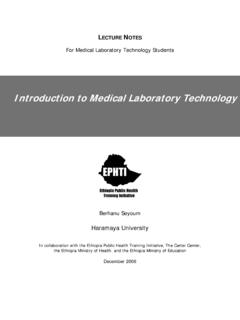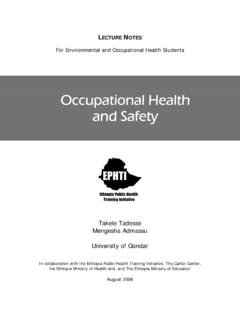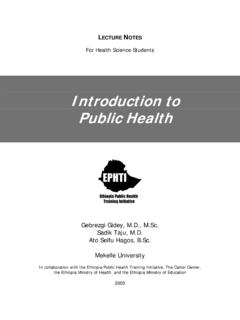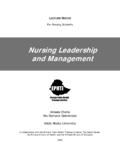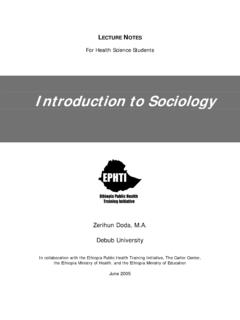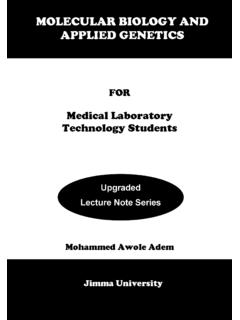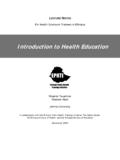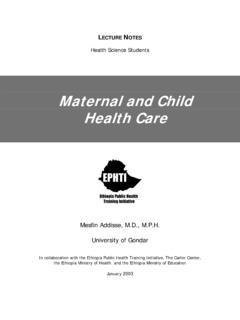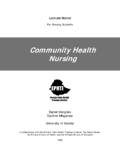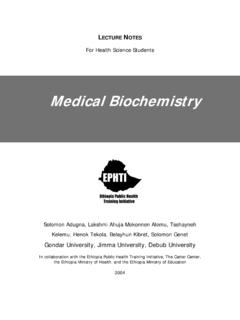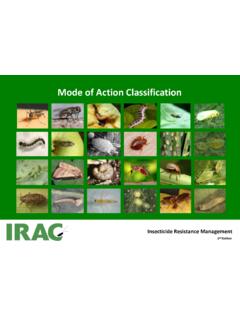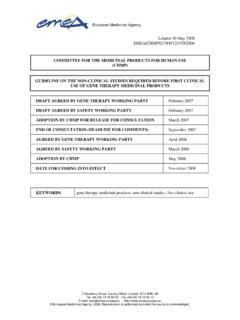Transcription of lecnote fm Med Biochem - Waging Peace, Fighting Disease ...
1 LECTURE NOTES. For Health Science Students Medical Biochemistry Solomon Adugna, Lakshmi Ahuja Mekonnen Alemu, Tsehayneh Kelemu, Henok Tekola, Belayhun Kibret, Solomon Genet Gondar University, Jimma University, Debub University In collaboration with the Ethiopia Public Health Training Initiative, The Carter Center, the Ethiopia Ministry of Health, and the Ethiopia Ministry of Education 2004. Funded under USAID Cooperative Agreement No. 663-A-00-00-0358-00. Produced in collaboration with the Ethiopia Public Health Training Initiative, The Carter Center, the Ethiopia Ministry of Health, and the Ethiopia Ministry of Education.
2 Important Guidelines for Printing and Photocopying Limited permission is granted free of charge to print or photocopy all pages of this publication for educational, not-for-profit use by health care workers, students or faculty. All copies must retain all author credits and copyright notices included in the original document. Under no circumstances is it permissible to sell or distribute on a commercial basis, or to claim authorship of, copies of material reproduced from this publication. 2004 by Solomon Adugna, Lakshmi Ahuja Mekonnen Alemu, Tsehayneh Kelemu, Henok Tekola, Belayhun Kibret, Solomon Genet All rights reserved.
3 Except as expressly provided above, no part of this publication may be reproduced or transmitted in any form or by any means, electronic or mechanical, including photocopying, recording, or by any information storage and retrieval system, without written permission of the author or authors. This material is intended for educational use only by practicing health care workers or students and faculty in a health care field. Table of Contents Table of i v Introduction .. vi Solomon Adugna and Lakshmi Ahuja Unit One: Enzymes .. 1. Henok Tekola Principles and classifications of Enzymes.
4 5. Mechanism action of Enzymes .. 7. Enzyme Inhibition .. 13. Regulation of Enzyme activity .. 18. Enzymes in clinical diagnosis .. 19. Unit Two: Carbohydrate Metabolism .. 23. Belayhun Kibret Chemistry of Carbohydrates .. 23. Functions of Carbohydrates .. 31. Digestion and absorption of Carbohydrates .. 33. Glycolysis .. 35. Glycogen Metabolism .. 42. Glycogen storage diseases .. 45. Pentose phosphate pathway .. 46. The Cori - cycle .. 48. Gluconeogenesis .. 49. Unit Three: Integrative Metabolism Bioenergetics .. 54. Tsehayneh Kelemu Introduction .. 54. Structural basis of high energy phosphate.
5 55. Formation and utilization of ATP .. 56. Catabolism of fuel molecules .. 56. Concept of Free energy .. 58. Oxidation-reduction reactions .. 58. Aerobic energy generation .. 61. Kreb's cycle .. 63. Function and regulation of kreb's cycle .. 70. i Electron transport system and oxidative Phosphorylation .. 71. Respiratory control .. 77. Uncouplers .. 77. Respiratory poisons .. 78. Unit Four: Lipid Metabolism .. 80. Solomon Genet Classification of Lipids .. 80. Types of Lipids .. 80. Digestion and absorption of Lipids .. 86. Metabolism of Fatty acids and Triacyl Glycerols.
6 88. -Oxidation of Fatty acids .. 90. Metabolism of Ketone bodies .. 93. Biosynthesis of Fatty acids and triacyl glycerols .. 97. Cholesterol Metabolism .. 99. Atherosclerosis .. 101. Hypercholesterolemic drugs .. 101. Lipid storage diseases .. 102. Fatty Liver .. 102. Lipoproteins .. 102. Chemical compositions of Membranes .. 104. Unit Five: Amino acids and Proteins .. 105. Solomon Adugna Classification of amino acids .. 106. Properties of amino acids .. 115. Peptides .. 119. Glutathione synthesis .. 121. Proteins .. 124. Classifications of proteins .. 124. Levels of organization of proteins.
7 126. Denaturation of proteins .. 131. Hemoglobin and Myoglobin .. 135. Sickle cell Hemoglobin .. 136. Sickle cell Disease , Sickle cell 136. Digestion and absorption of proteins .. 137. Amino acid catabolism .. 141. Nitrogen balance, excretion and the urea 144. ii Defects in the urea cycle .. 150. The Glucose - Alanine cycle .. 151. Inborn errors of amino acid 152. Amino acid derived nitrogenous compounds .. 154. Clinical problems .. 159. Unit Six: Vitamins and Coenzymes .. 161. Solomon Adugna Water soluble vitamins .. 161. Chemistry, sources, function and deficiency of: Thamine.
8 161. Riboflavin .. 163. Niacin .. 164. Pyridoxine .. 165. Biotin .. 166. Cobalamin .. 167. Folic acid .. 169. Panthothenic .. 170. Ascorbic acid .. 171. Fat soluble vitamins .. 172. Chemistry, Sources, function, deficiency and Hypervitaminosis of: Vitamin A .. 173. Vitamin D .. 177. Vitamin E .. 179. Vitamin K .. 181. Unit Seven: Miniral Metabolism .. 183. Lakshmi Ahuja Mineral .. 183. Sodium and potassium .. 183. Calcium and Phosphate .. 184. Trace elements .. 185. Iron .. 185. Copper .. 187.. 188. Flourine .. 188. Iodine .. 189. Zinc .. 189. iii Selenium .. 191. Unit Eight: Hormones.
9 193. Lakshmi Ahuja Definition and classification .. 194. Biosynthesis, storage, transport .. 196. Mechanism of action of steroid hormones .. 197. Mechanism of action of protein hormones .. 198. Receptors and diseases .. 202. Second messengers .. 203. Insulin synthesis, secretion and metabolic role .. 205. Diabetes mellitus .. 209. Symptoms and complications of DM.. 210. Glucagon .. 211. Clinical .. 212. Thyroxin .. 213. Synthesis and Metabolism .. 213. Hypo and Hyper Thyroidism .. 214. Goiter .. 215. Catecholamines .. 216.. 217. Case Histories .. 217. Unit Nine: Molecular Genetics.
10 220. Mekonnen Alemu Structure of Nucleic acids .. 220. Types of Nucleic acids .. 226. Replication of DNA .. 230. DNA Damage and repair mechanism .. 231. RNA synthesis .. 233. Post transcriptional Modifications .. 236. Translation/Protein synthesis .. 240. Regulation of protein synthesis .. 242. The Genetic code .. 243. Post translational processes .. 244. Glossary .. 246. Reference .. 253. iv ACKNOWLEDGMENT. The team of authors from the department of Biochemistry of various Universities would like to thank and express their deep rooted gratitude to the Carter Center (EPHTI) for its initiation and drive to prepare this teaching material.
